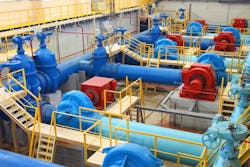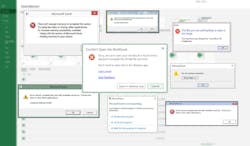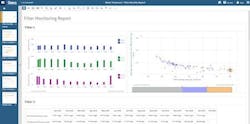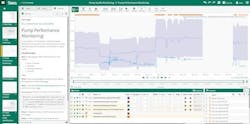About the author:
Sean Tropsa is analytics engineer for Seeq. Tropsa can be reached at [email protected].
Across industrial wastewater treatment facilities modern automation is enabling the inexpensive generation and collection of massive amounts of process data. The propensity to make decisions by gut feel may seem far-fetched to a bystander, but for many plant personnel, adjusting processes based upon instinct is an all too familiar occurrence.
These decisions are often made on the fly because sifting through massive volumes of data to find the proper insights can be a paralyzing task. Add the challenge of manual analysis to this data wrangling struggle, along with the difficulty of producing data-based insights, and the reasons for frequent fallback to instinct becomes evident.
To address these and other issues, advanced analytics software can be used to help plant personnel move beyond the practice of decision-making on the fly. It empowers subject matter experts (SMEs) to dig into process problems, gain insights and make data-based decisions—all without the need for manual data wrangling or analysis.
Challenges for Industrial Wastewater Treatment
Wastewater treatment facilities are digitizing their processes to drive more stable and reliable waste neutralization processes. Simultaneously, new products and manufacturing methods are increasing variability in contaminant composition and concentration, resulting in a need for greater visibility of equipment health and treated outflow data (see Figure 1 on page 21).
Plant personnel are therefore being asked to examine increasingly larger data sets to determine how efficiently equipment is operating in their efforts to implement contaminant neutralization at minimal cost. While modern multi-component systems automatically capture large quantities of equipment data, these complex systems do not necessarily help personnel pinpoint the cause of inefficiencies and problems.
Graphs and charts displaying raw tag history can provide ideas, but advanced analytics software enables SMEs to see a much clearer picture. This type of software enables quick problem identification, along with collaboration among team members to produce and share insights. These insights empower SMEs to make informed decisions for process improvement.
Manual Method Inadequacies
In industrial wastewater facilities raw process data is often siloed into segregated historians, SQL databases or comma-separated values files. Combining records from disparate sources is an arduous effort requiring excessive time and a high level of expertise. Once the data is properly oriented in a spreadsheet, data restriction methods like down-sampling are commonly used. This ensures the spreadsheet software can handle the desired data, but it often results in a loss of data fidelity or lack of a full picture as lengthy spreads of data are reduced to points taken during a small slice of time.
These limitations can derail analyses, and when an SME realizes partway through that required data is missing, frustration naturally follows. Even in the event a full data picture remains intact, there are myriad possible errors within the spreadsheet software as the SME operates on the data or attempts to share findings with other team members (see Figure 2 on page 20).
SMEs often do not have time to wrangle the required data and then analyze it. As a result, they cannot create data insights, and process problems go unanswered. Thoughts and hunches for improved efficiency remain unexplored and anticipated benefits from improvement projects remain unquantified.
Advanced Analytics Software Provides Solutions
Advanced analytics software, such as Seeq, addresses the inadequacies of manual methods, enabling SMEs to rely on data for generating insights and improving plant processes. Advanced analytics software connects to all historians and data sources within a facility and provides access to it as a unified experience for the user, eliminating data wrangling frustration. From here, the data may be leveraged for predictive, descriptive and diagnostic analytics — empowering users to quickly identify trends, find insights and make decisions.
Furthermore, advanced analytics software is web-based, empowering teams to work together on the same worksheet regardless of geographic location. Users can record notes, save views and embed context or tribal knowledge so their work can be leveraged by others and preserved for the future. They can also:
- Quickly apply smoothing algorithms;
- Identify and account for plant downtime;
- Create models in minutes; and
- Automate report generation.
These and other functions free up valuable SME time so they can drive further plant improvements. Additionally, coworking capabilities increase opportunities for team collaboration and connection.
Success Stories
Spending less time aggregating data and devoting more attention to analysis helps operators and engineers maintain engagement with their plants, as demonstrated in the following success stories.
1. A Problem With pH
An SME at a chemical facility was having difficulty identifying failures of a neutralization tank pH sensor. In the application, highly acidic wastewater was fed into the tank, periodically dosed with a basic chemical to achieve neutral pH prior to discharge. Detecting sensor failure was difficult because the failed sensor continued to read within the standard operating range.
Using advanced analytics software, pH was calculated in near real time based on inflow of acidic and neutralizing agents, and this calculated value was then compared against the installed pH sensor’s measured value. By implementing this ‘soft sensor,’ the SME was able to ensure tank contents were properly neutralized, while introducing process redundancy without the need for additional equipment.
2. Report Generation Revelation
An SME responsible for generating reports on wastewater discharge at a large manufacturing facility used to regularly spend days gathering, aligning and cleansing the requisite data. The data was then integrated into tables and graphs to display discharge of contaminants from the facility, in addition to the total volume and quality of treated discharge. By applying advanced analytics software, the SME was able to recreate this process with Seeq advanced analytics software.
As a result, she was able to generate reports on a more frequent basis, enabling daily monitoring of the treatment process, and she freed up several hours each month for process improvement tasks (Figure 3).
3. Pump Operation Improvements
Prior to deploying advanced analytics software, an SME was attempting to monitor the operational health of several transfer pumps. While attempting to analyze the data in a single spreadsheet, however, the spreadsheet software often experienced a memory error due to the large amounts of required data collection over extensive periods.
The SME wanted to estimate the percentage of time each pump spent in its flow regimes based on outlet flow and pressure. Advanced analytics software empowered the SME to calculate these values in real-time, and it also enabled him to compute an expected flow range based on the pump curve (Figure 4).
Using this information in conjunction with actual flow data, the SME was able to detect when a pump was deviating from designed operation, and he further used this information to generate an operational health score for each pump.
Freeing Up Time
Growing weary of wrangling disparate data from different sources and creating insights using traditional tools, an increasing number of engineers responsible for the operation of industrial wastewater facilities are turning to advanced analytics software. This frees up precious time to focus on process improvement, troubleshooting and predictive maintenance. Once resigned to decisions on the fly, plant personnel can now easily collaborate to produce analyses that tell stories, giving them the confidence to make well-informed operational decisions.
As a cloud-hosted advanced analytics application, Seeq is uniquely poised to help SMEs in industrial wastewater drive their data analytic methodologies forward. Advanced analytics software is enabling facilities to connect to many types of data sources, and to then transform information into insights for improved process efficiency.
About the Author
Sean Tropsa
Sean Tropsa is analytics engineer for Seeq. Tropsa can be reached at [email protected].



